Formulations for Estimating Spatial Variations of Analysis Error Variance to Improve Multiscale and Multistep Variational Data Assimilation
Abstract
When the coarse-resolution observations used in the first step of multiscale and multistep variational data assimilation become increasingly nonuniform and/or sparse, the error variance of the first-step analysis tends to have increasingly large spatial variations. However, the analysis error variance computed from the previously developed spectral formulations is constant and thus limited to represent only the spatially averaged error variance. To overcome this limitation, analytic formulations are constructed to efficiently estimate the spatial variation of analysis error variance and associated spatial variation in analysis error covariance. First, a suite of formulations is constructed to efficiently estimate the error variance reduction produced by analyzing the coarse-resolution observations in one- and two-dimensional spaces with increased complexity and generality (from uniformly distributed observations with periodic extension to nonuniformly distributed observations without periodic extension). Then, three different formulations are constructed for using the estimated analysis error variance to modify the analysis error covariance computed from the spectral formulations. The successively improved accuracies of these three formulations and their increasingly positive impacts on the two-step variational analysis (or multistep variational analysis in first two steps) are demonstrated by idealized experiments.
1. Introduction
Multiple Gaussians with different decorrelation length scales have been used at NCEP to model the background error covariance in variational data assimilation (Wu et al. [1], Purser et al. [2]), but mesoscale features are still poorly resolved in the analyzed incremental fields even in areas covered by remotely sensed high-resolution observations, such as those from operational weather radars (Liu et al. [3]). This problem is common for the widely adopted single-step approach in operational variational data assimilation, especially when patchy high-resolution observations, such as those remotely sensed from radars and satellites, are assimilated together with coarse-resolution observations into a high-resolution model. To solve this problem, multiscale and multistep approaches were explored and proposed by several authors (Xie et al. [4], Gao et al. [5], Li et al. [6], and Xu et al. [7, 8]). For a two-step approach (or the first two steps of a multistep approach) in which broadly distributed coarse-resolution observations are analyzed first and then locally distributed high-resolution observations are analyzed in the second step, an important issue is how to objectively estimate or efficiently compute the analysis error covariance for the analyzed field that is obtained in the first step and used to update the background field in the second step. To address this issue, spectral formulations were derived by Xu et al. [8] for estimating the analysis error covariance. As shown in Xu et al. [8], the analysis error covariance can be computed very efficiently from the spectral formulations with very (or fairly) good approximations for uniformly (or nonuniformly) distributed coarse-resolution observations and, by using the approximately computed analysis error covariance, the two-step analysis can outperform the single-step analysis under the same computational constraint (that mimics the operational situation).
The analysis error covariance functions computed from the spectral formulations in Xu et al. [8] are spatially homogeneous, so their associated error variances are spatially constant. Although such a constant error variance can represent the spatial averaged value of the true analysis error variance, it cannot capture the spatial variation in the true analysis error variance. The true analysis error variance can have significant spatial variations, especially when the coarse-resolution observations become increasingly nonuniform and/or sparse. In this case, the spatial variation of analysis error variance and associated spatial variation in analysis error covariance need to be estimated based on the spatial distribution of the coarse-resolution observations in order to further improve the two-step analysis. This paper aims to explore and address this issue beyond the preliminary study reported in Xu and Wei [9]. In particular, as will be shown in this paper, analytic formulations for efficiently estimating the spatial variation of analysis error variance can be constructed by properly combining the error variance reduction produced by analyzing each and every coarse-resolution observation as a single observation, and the estimated analysis error variance can be used to further estimate the related variation in analysis error covariance. The detailed formulations are presented for one-dimensional cases first in the next section and then extended to two-dimensional cases in Section 3. Idealized numerical experiments are performed for one-dimensional cases in Section 4 and for two-dimensional cases in Section 5 to show the effectiveness of these formulations for improving the two-step analysis. Conclusions follow in Section 6.
2. Analysis Error Variance Formulations for One-Dimensional Cases
2.1. Error Variance Reduction Produced by a Single Observation
2.2. Uniform Coarse-Resolution Observations with Periodic Extension
As shown by the example in Figure 1 (in which D = 110.4 km and M = 10 so Δxco = D/M = 11.04 km is close to L = 10 km), the estimated in (7) has nearly the same spatial variation as the benchmark that is computed precisely from (1b), although the amplitude of spatial variation of , defined by , is slightly smaller than that of the true , defined by . As shown in Figure 2, the amplitude of spatial variation of benchmark decreases rapidly to virtually zero and then exactly zero (or increases monotonically toward its asymptotic upper limit of m2 s−2) as Δxco/L decreases to 0.5 and then to Δx/L = 0.1 (or increases toward ∞), and this decrease (or increase) of the amplitude of spatial variation of with Δxco/L is closely captured by the amplitude of spatial variation of the estimated as a function of Δxco/L.
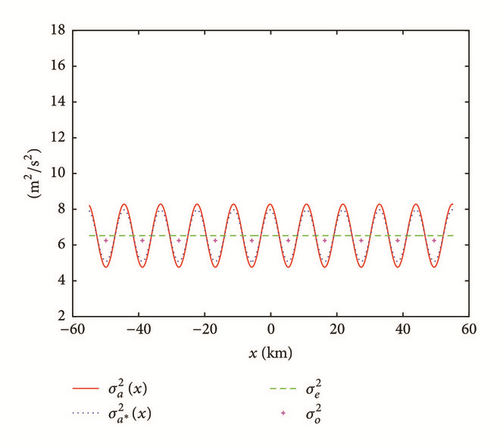
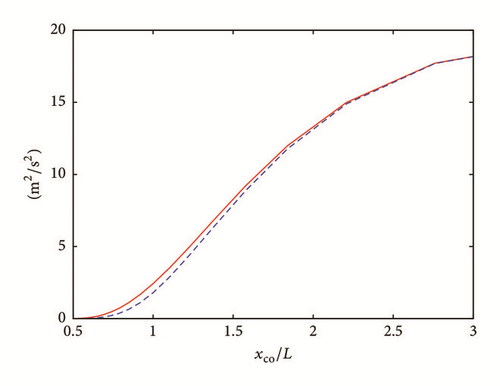
For the case in Figure 1, the benchmark analysis error covariance matrix, denoted by A, is computed precisely from (1b) and is plotted in Figure 3, while the deviations of Ae, Aa, Ab, and Ac from the benchmark A are shown in Figures 4(a), 4(b), 4(c), and 4(d), respectively. As shown, the deviation becomes increasingly small when Ae is modified successively to Aa, Ab, and Ac. Note that the correction term in (8a) is Ca(xi − xj) modulated by . This modulation has a chessboard structure, while the desired modulation revealed by the to-be-corrected deviation of Ac in Figure 4(a) has a banded structure (along the direction of xi + xj = constant, perpendicular to the diagonal line). This explains why the correction term in (8a) offsets only a part of the deviation as revealed by the deviation of Aa in Figure 4(b). On the other hand, the correction term in (8b) is modulated by . This modulation not only retains the self-adjointness but also has the desired banded structure, so the correction term in (8b) is an improvement over that in (8a), as shown by the deviation of Ab in Figure 4(c) versus that of Aa in Figure 4(b). However, as revealed by Figure 4(c), the deviation of Ab still has two significant maxima (or minima) along each band on the two sides of the diagonal line of xi = xj, while the to-be-corrected deviation of Ae in Figure 4(a) has a single maximum (or minimum) along each band. This implies that the function form of Ca(xi − xj) is not sufficiently wide for the correction. As a further improvement, this function form is widened to Cb(xi − xj) for the correction term in (8c), so the deviation of Ac in Figure 4(d) is further reduced from that of Ab in Figure 4(c).
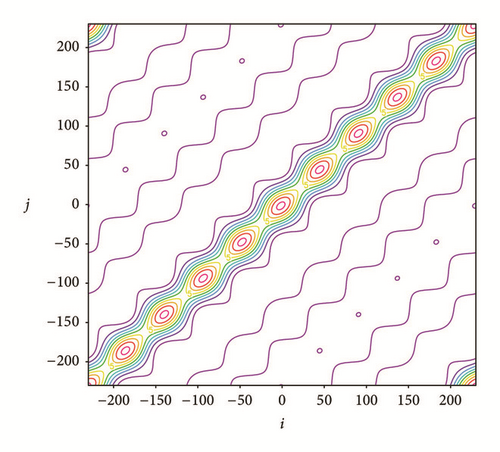
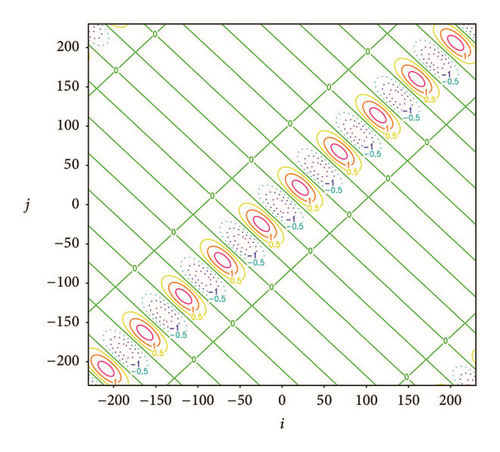
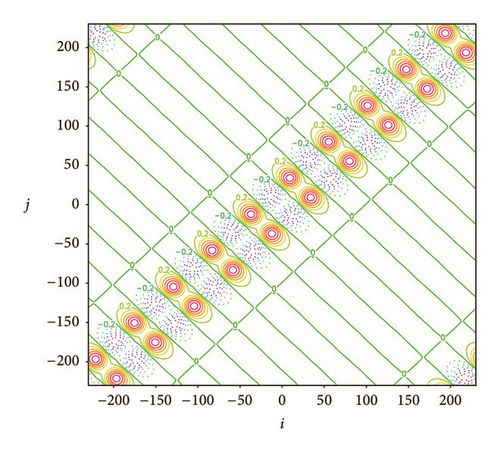
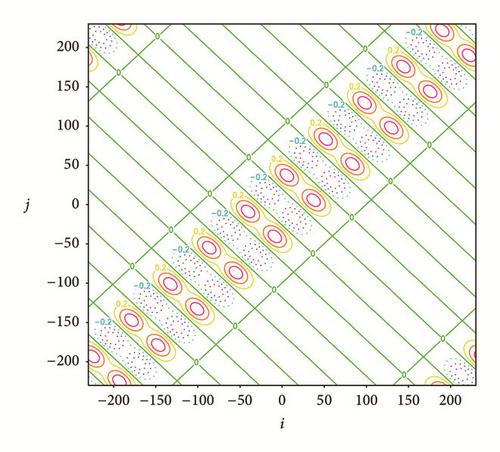
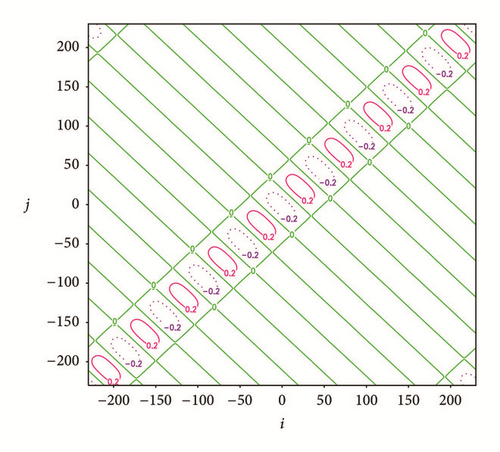
| Experiment | n = 20 | n = 50 | n = 100 | Final |
|---|---|---|---|---|
| SE | 0.671 | 0.365 | 0.187 | 0.013 at n = 481 |
| TEe with RE(Ae) = 0.229 | 0.171 | 0.150 | 0.142 | 0.135 at n = 210 |
| TEa with RE(Aa) = 0.156 | 0.169 | 0.142 | 0.144 | 0.144 at n = 116 |
| TEb with RE(Ab) = 0.101 | 0.147 | 0.098 | 0.090 at n = 67 | |
| TEc with RE(Ac) = 0.042 | 0.145 | 0.063 | 0.062 | 0.032 at n = 176 |
2.3. Nonuniform Coarse-Resolution Observations with Periodic Extension
Consider that the M coarse-resolution observations are now nonuniformly distributed in the analysis domain of length D with periodic extension, so their averaged resolution can be defined by Δxco ≡ D/M. The spacing of a concerned coarse-resolution observation, say the mth observation, from its right (or left) adjacent observation can be denoted by Δxcom+ (or Δxcom−). Now we can consider the following two limiting cases.
The analysis error variance is then estimated by as in (7), except that is computed by (12a) instead of (6). As shown by the example in Figure 5, the estimated captures closely not only the maximum and minimum but also the spatial variation of the benchmark computed from (1b). Using this estimated , the previously estimated Ae from the spectral formulation can be modified into Aa, Ab, or Ac with its ijth element given by the same formulation as shown in (8a), (8b), or (8c). For the case in Figure 5, the benchmark A is plotted in Figure 6, while the deviations of Ae, Aa, Ab, and Ac from the benchmark A are shown in Figures 7(a), 7(b), 7(c), and 7(d), respectively. As shown, the deviation becomes increasingly small when the estimated analysis error covariance matrix is modified successively to Aa, Ab, and Ac.
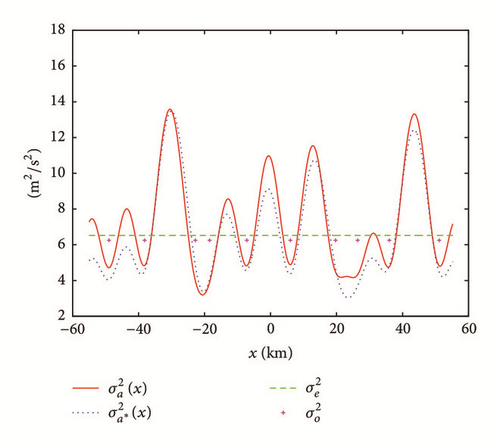
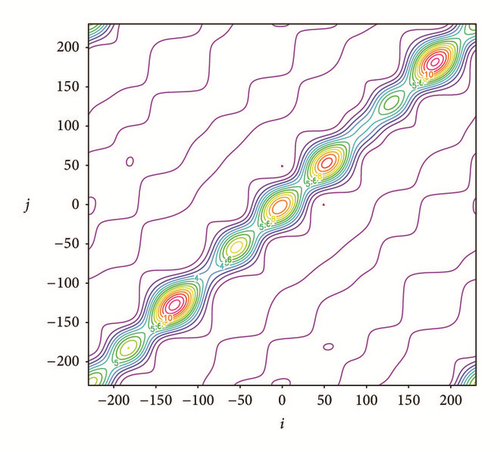
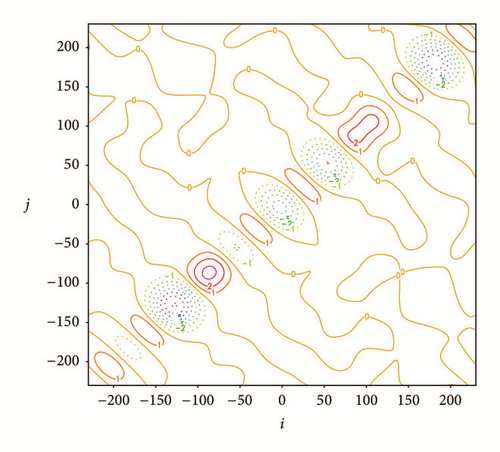


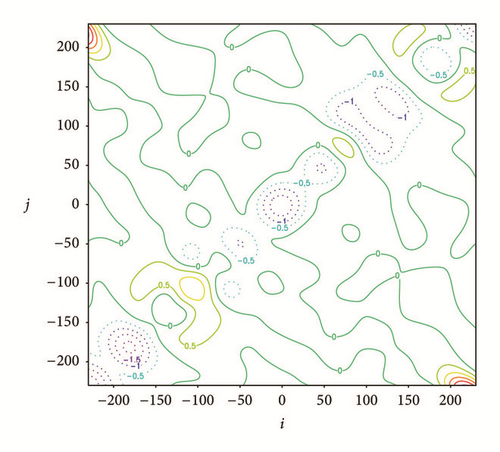
As explained in Section 2.2, the accuracy of the second-step analysis depends on the accuracy of the estimated A over the extended nested domain (i.e., the nested domain plus its extended vicinities within the distance of 2La on each side outside the nested domain), while the latter can be measured by the smallness of the RE of the estimated A with respect to the benchmark A, as defined for Ae in (9). The REs of Ae, Aa, Ab, and Ac computed for the case in Figure 5 are listed in the first column of Table 2. As listed, the RE becomes increasingly small when Ae is modified successively to Aa, Ab, and Ac, which quantifies the successively reduced deviation shown in Figures 7(a)–7(d).
| Experiment | n = 20 | n = 50 | n = 100 | Final |
|---|---|---|---|---|
| SE | 0.711 | 0.334 | 0.276 | 0.018 at n = 404 |
| TEe with RE(Ae) = 0.355 | 0.482 | 0.439 | 0.442 at n = 76 | |
| TEa with RE(Aa) = 0.238 | 0.418 | 0.388 | 0.348 | 0.353 at n = 108 |
| TEb with RE(Ab) = 0.197 | 0.318 | 0.288 | 0.257 | 0.243 at n = 179 |
| TEc with RE(Ac) = 0.148 | 0.213 | 0.151 | 0.155 at n = 52 |
2.4. Nonuniform Coarse-Resolution Observations without Periodic Extension
Consider that the M coarse-resolution observations are still nonuniformly distributed in the one-dimensional analysis domain of length D but without periodic extension. In this case, their produced error variance reduction still can be estimated by (12a) except for the following three modifications.
(i) The maximum (or minimum) of , that is, (or ), should be found in the interior domain between the leftist and rightist observation points.
(ii) For the leftist (or rightist) observation that has only one adjacent observation to its right (or left) in the one-dimensional analysis domain, its error variance is still adjusted from to but βm is calculated by setting [or (Δxcom+) = 0] in (11a) for calculating γm in (11b).
The analysis error variance is estimated by as in (7), except that is computed by (12a) [or (12b)] for x within (or beyond) the interior domain. As shown by the example in Figure 8, the estimated captures closely the spatial variation of the benchmark not only within but also beyond the interior domain. Using this estimated , Ae can be modified into Aa, Ab, or Ac with its ijth element given by the same formulation as shown in (8a), (8b), or (8c). For the case in Figure 8, the benchmark A (not shown) has the same interior structure (for interior grid points i and j) as that for the case with periodic extension in Figure 6, but significant differences are seen in the following two aspects around the four corners (similar to those seen from Figures 7(a) and 11(a) of Xu et al. [8]). (i) The element value becomes large toward the two corners along the diagonal line (which is consistent with the increased analysis error variance toward the two ends of the analysis domain as shown in Figure 8 in comparison with that in Figure 5). (ii) The element value becomes virtually zero toward the two off-diagonal corners (because there is no periodic extension). The deviations of Ae, Aa, Ab, and Ac from the benchmark A are shown in Figures 9(a), 9(b), 9(c), and 9(d), respectively, for the case in Figure 8. As shown, the deviation becomes increasingly small when the estimated analysis error covariance matrix is modified successively to Aa, Ab, and Ac. The REs of Ae, Aa, Ab, and Ac are listed in the first column of Table 3. As listed, the RE becomes increasingly small when Ae is modified successively to Aa, Ab, and Ac, which quantifies the successively reduced deviation shown in Figures 9(a)–9(d).
| Experiment | n = 20 | n = 50 | n = 100 | Final |
|---|---|---|---|---|
| SE | 0.499 | 0.328 | 0.194 | 0.012 at n = 451 |
| TEe with RE(Ae) = 0.355 | 0.463 | 0.424 | 0.399 at n = 73 | |
| TEa with RE(Aa) = 0.238 | 0.394 | 0.358 | 0.385 at n = 54 | |
| TEb with RE(Ab) = 0.196 | 0.281 | 0.273 | 0.248 at n = 77 | |
| TEc with RE(Ac) = 0.147 | 0.215 | 0.149 | 0.123 at n = 77 |
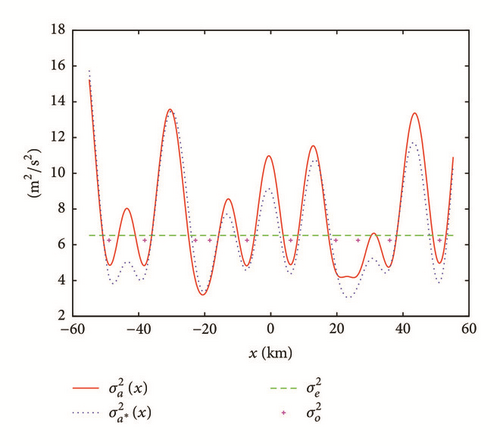
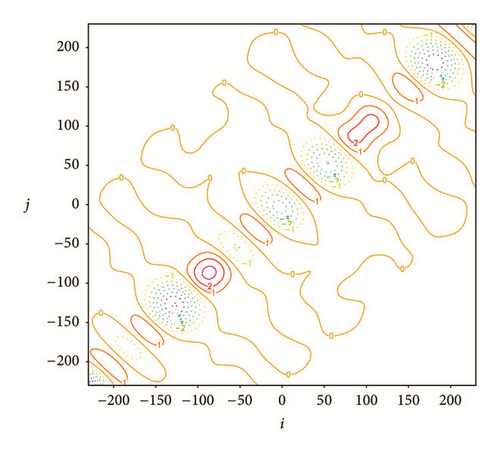
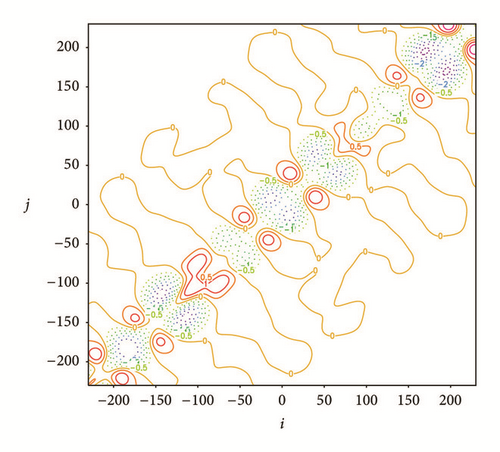
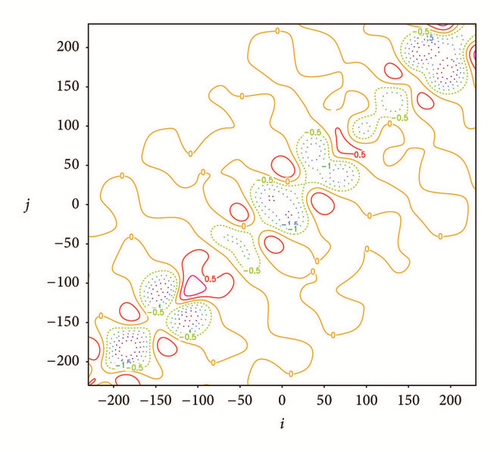
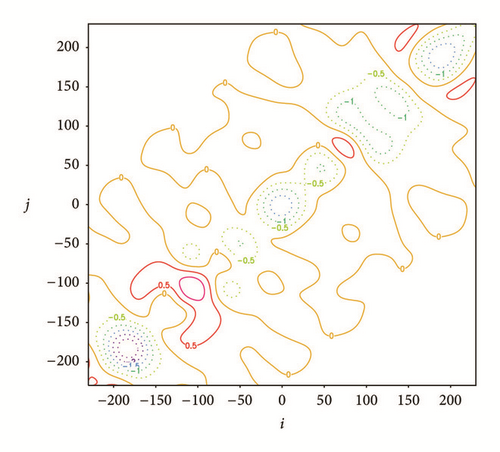
3. Analysis Error Variance Formulations for Two-Dimensional Cases
3.1. Error Variance Reduction Produced by a Single Observation
For a single observation, say, at xm ≡ (xm, ym) in the two-dimensional space of x = (x, y), the inverse matrix in (1b) also reduces to , so the ith diagonal element of A is given by the same formulation as in (2) except that xi (or xm) is replaced by xi (or xm). Here, xi denotes the ith point in the discretized analysis space RN with N = NxNy, Nx (or Ny) is the number of analysis grid points along the x (or y) direction in the two-dimensional analysis domain. The length (or width) of the analysis domain is Dx = NxΔx (or Dy = NyΔy) and is assumed to be much larger than the background error decorrelation length scale L in x, where Δx (or Δy) is the grid spacing in the x (or y) direction and Δx = Δy is assumed for simplicity.
3.2. Uniform Coarse-Resolution Observations with Periodic Extension
Consider that there are M coarse-resolution observations uniformly distributed in the above analysis domain of length Dx and width Dy with periodic extension along x and y, so their resolution is /M1/2, where M = MxMy, Mx (or My) denotes the number of observations uniformly distributed along the x (or y) direction in the two-dimensional analysis domain, and Dx/Mx = Dy/My is assumed (so Δxco = Dx/Mx = Dy/My). In this case, as explained for the one-dimensional case in Section 2.2, the error variance reduction produced by each observation can be considered as an additional reduction to the reduction produced by its neighboring observations. This additional reduction is smaller than the reduction produced by a single observation, so the error variance reduction produced by analyzing the M coarse-resolution observations is bounded above by , which is similar to that for the one-dimensional case in (4). For the same reason as explained for the one-dimensional case in (4), this implies that the domain-averaged value of is larger than the true averaged reduction estimated by , where is the domain-averaged analysis error variance estimated by the spectral formulation for two-dimensional cases in Section 2.3 of Xu et al. [8].
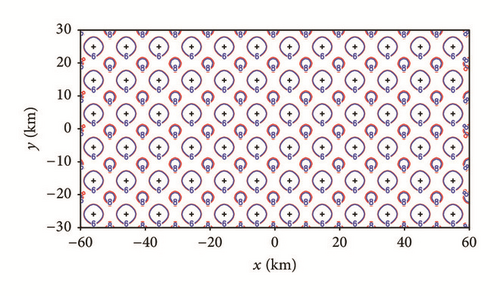
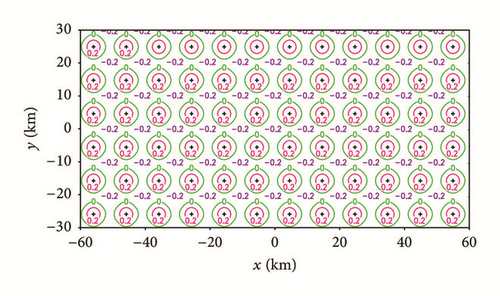
Using the estimated in (16), the previously estimated analysis error covariance matrix, denoted by Ae with its ijth element obtained from the spectral formulation, can be modified into Aa, Ab, or Ac with its ijth element given by the same formulation as in (8a), (8b), or (8c) except that xi (or xj) is replaced by xi (or xj). Again, as explained in Section 2.2 but for the two-dimensional case here, the accuracy of the second-step analysis depends on the accuracy of the estimated A over the extended nested domain, that is, the nested domain plus its extended vicinities within the distance of 2La outside the nested domain. Here, La is the decorrelation length scale of Ca(x) defined by according to (4.3.12) of Daley [12], and La (=4.52 km for the case in Figure 10) can be easily computed as a by-product from the spectral formulation. Over this extended nested domain, the relative error (RE) of each estimated A with respect to the benchmark A computed precisely from (1b) can be defined in the same way as that for Ae in (9), except that the extended nested domain is two-dimensional here. The REs of Ae, Aa, Ab, and Ac computed for the case in Figure 10 are listed in the first column of Table 4. As listed, the RE becomes increasingly small when Ae is modified successively to Aa, Ab, and Ac.
| Experiment | n = 20 | n = 50 | n = 100 | Final |
|---|---|---|---|---|
| SE | 0.742 | 0.364 | 0.154 | 0.071 at n = 201 |
| TEe with RE(Ae) = 0.233 | 0.394 | 0.185 | 0.108 | 0.104 at n = 140 |
| TEa with RE(Aa) = 0.181 | 0.397 | 0.186 | 0.102 | 0.097 at n = 145 |
| TEb with RE(Ab) = 0.130 | 0.403 | 0.183 | 0.089 | 0.085 at n = 133 |
| TEc with RE(Ac) = 0.038 | 0.397 | 0.160 | 0.064 | 0.059 at n = 183 |
3.3. Nonuniform Coarse-Resolution Observations with Periodic Extension
The analysis error variance is then estimated by as in (16), except that is computed by (19a). As shown by the example in Figure 11, the estimated (x) is fairly close to the benchmark , and the deviation of from the benchmark (x) is within (−2.40, 4.20) m2s−2. On the other hand, the constant analysis error variance ( m2s−2) estimated by the spectral formulation deviates from the benchmark widely from −9.98 to 3.83 m2s−2. Using this estimated , the previously estimated Ae from the spectral formulation can be modified into Aa, Ab, or Ac with its ijth element given by the same two-dimensional version of (8a), (8b), or (8c) as explained in Section 3.2. The REs of Ae, Aa, Ab, and Ac computed for the case in Figure 11 are listed in the first column of Table 5. As listed, the RE becomes increasingly small when Ae is modified successively to Aa, Ab, and Ac.
| Experiment | n = 20 | n = 50 | n = 100 | Final |
|---|---|---|---|---|
| SE | 0.757 | 0.364 | 0.175 | 0.069 at n = 241 |
| TEe with RE(Ae) = 0.462 | 0.416 | 0.202 | 0.149 | 0.144 at n = 140 |
| TEa with RE(Aa) = 0.274 | 0.411 | 0.202 | 0.143 | 0.144 at n = 215 |
| TEb with RE(Ab) = 0.244 | 0.402 | 0.195 | 0.136 | 0.132 at n = 191 |
| TEc with RE(Ac) = 0.165 | 0.403 | 0.179 | 0.106 | 0.103 at n = 287 |
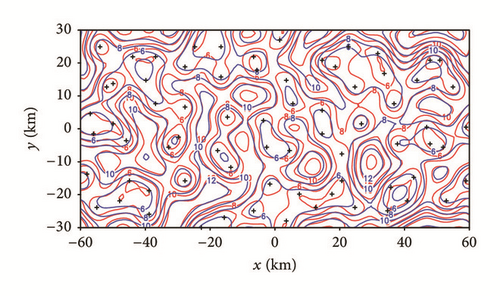
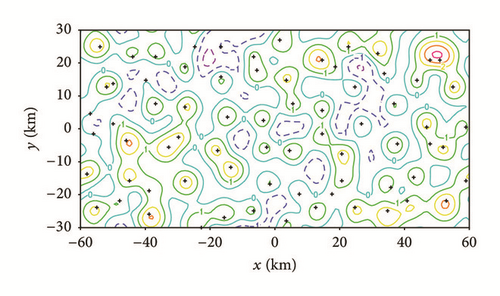
3.4. Nonuniform Coarse-Resolution Observations without Periodic Extension
Consider that the M coarse-resolution observations are still nonuniformly distributed in the analysis domain of length Dx and width Dy but without periodic extension. In this case, their averaged resolution is still defined by . To estimate their produced error variance reduction, we need to modify the formulations constructed in the previous subsection with the following preparations. First, we need to identify four near-corner observations among all the coarse-resolution observations. Each near-corner observation is defined as the one that nearest to one of the four corners of the analysis domain. Then, we need to identify Mx − 2 (or My − 2) near-boundary observations associated with each x-boundary (or y-boundary), where Mx (or My) is estimated by the nearest integer to Dx/Δxco (or Dy/Δxco). The total number of near-boundary observations is thus given by 2(Mx + My) − 8. To identify these near-boundary observations, we need to divide the 2D domain uniformly along the x-direction and y-direction into MxMy boxes, so there are 2(Mx + My) − 8 boundary boxes (not including the four corner boxes). If a boundary box contains no coarse-resolution observation, then it is an empty box and should be substituted by its adjacent interior box (as a substituted boundary box). From each nonempty boundary box (including substituted boundary box), we can find one near-boundary observation that is nearest to the associated boundary. A closed loop of observation boundary can be constructed by piece-wise linear segments with every two neighboring near-boundary observation points connected by a linear segment and with each near-corner observation point connected by a linear segment to each of its two neighboring near-boundary observation points.
After the above preparations, the error variance reduction can be estimated by (19a) with the following three modifications:
(i) The maximum (or minimum) of , that is, (or ) should be found in the interior domain of |x | < Dx/2 − Δxco and |y | < Dy/2 − Δxco.
(ii) For each above defined near-boundary (or near-corner) observation that has only three (or two) adjacent observations, its error variance is still adjusted from to but βm is calculated by setting in (18a) for k = 4 (or k = 3 and 4).
The analysis error variance is estimated by as in (16), except that is computed by (19a) [or (19b)] for x inside (or outside) the closed observation boundary loop. As shown by the example in Figure 12, the estimated is fairly close to the benchmark , and the deviation of from the benchmark is within (−4.08, 5.54) m2s−2. On the other hand, the constant analysis error variance ( m2s−2) estimated by the spectral formulation deviates from the benchmark very widely from −16.1 to 3.82 m2s−2. Using the estimated , the previously estimated Ae from the spectral formulation can be modified into Aa, Ab, or Ac with its ijth element given by the same two-dimensional version of (8a), (8b), or (8c) as explained in Section 3.2. The REs of Ae, Aa, Ab, and Ac computed for the case in Figure 12 are listed in the first column of Table 6. As listed, the RE becomes increasingly small when Ae is modified successively to Aa, Ab, and Ac.
| Experiment | n = 20 | n = 50 | n = 100 | Final |
|---|---|---|---|---|
| SE | 0.808 | 0.453 | 0.176 | 0.078 at n = 235 |
| TEe with RE(Ae) = 0.462 | 0.509 | 0.179 | 0.136 | 0.134 at n = 161 |
| TEa with RE(Aa) = 0.305 | 0.497 | 0.184 | 0.146 | 0.140 at n = 213 |
| TEb with RE(Ab) = 0.258 | 0.495 | 0.179 | 0.135 | 0.127 at n = 170 |
| TEc with RE(Ac) = 0.240 | 0.473 | 0.157 | 0.103 | 0.101 at n = 201 |
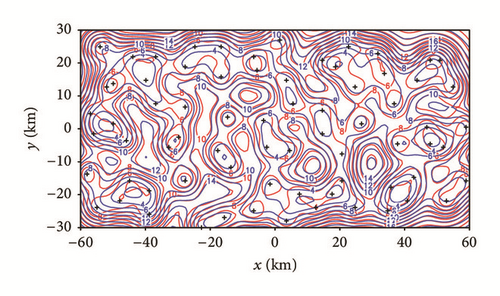
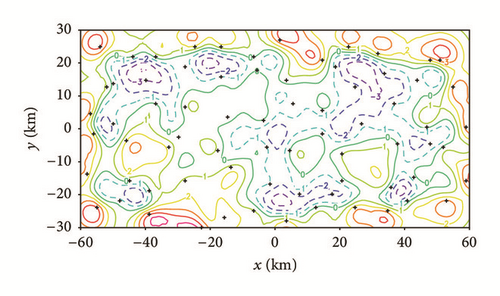
4. Numerical Experiments for One-Dimensional Cases
4.1. Experiment Design and Innovation Data
In this section, idealized one-dimensional experiments are designed and performed to examine to what extent the successively improved estimate of A in (8a), (8b), and (8c) can improve the two-step analysis. In particular, four types of two-step experiments, named TEe, TEa, TEb, and TEc, are designed for analyzing the high-resolution innovations in the second step with the background error covariance updated by Ae, Aa, Ab, and Ac, respectively, after the coarse-resolution innovations are analyzed in the first step. The TEe is similar to the first type of two-step experiment (named TEA) in Xu et al. [8], but the TEa, TEb, and TEc are new here. As in Xu et al. [8], a single-step experiment, named SE, is also designed for analyzing all the innovations in a single step. In each of the above five types of experiments, the analysis increment is obtained by using the standard conjugate gradient descent algorithm to minimize the cost-function (formulated as in (7) of Xu et al. [8]) with the number of iterations limited to n = 20, 50, or 100 before the final convergence to mimic the computationally constrained situations in operational data assimilation. Three sets of simulated innovations are generated for the above five types of experiments. The first set consists of M (=10) uniformly distributed coarse-resolution innovations over the analysis domain (see Figure 1) with periodic extension and M′ (=74) high-resolution innovations in the nested domain of length D/6 (similar to those shown by the purple × signs in Figure 1 of Xu et al. [8] but generated at the grid points not covered by the coarse-resolution innovations within the nested domain). The second (or third) set is the same as the first set except that the coarse-resolution innovations are nonuniformly distributed with (or without) periodic extension as shown in Figure 5 (or Figure 8). All the innovations are generated by simulated observation errors subtracting simulated background errors at observation locations. Observation errors are sampled from computer-generated uncorrelated Gaussian random numbers with σo = 2.5 ms−1 for both coarse-resolution and high-resolution observations. Background errors are sampled from computer-generated spatially correlated Gaussian random fields with σb = 5 ms−1 and Cb(x) modeled by the double-Gaussian form given in Section 2.2 (also see the caption of Figure 1). The coarse-resolution innovations in the first, second, and third sets are thus generated in consistency with the three cases in Figures 1, 5, and 8, respectively.
4.2. Results from the First Set of Innovations
The first set of innovations is used here to perform each of the five types of experiments with the number of iterations limited to n = 20, 50, or 100 before the final convergence. The accuracy of the analysis increment obtained from each experiment with each limited n is measured by its domain-averaged RMS error (called RMS error for short hereafter) with respect to the benchmark analysis increment computed precisely from (1a). Table 1 lists the RMS errors of the analysis increments obtained from the SE, TEe, TEa, TEb, and TEc with the number of iterations increased from n = 20 to 50, 100, and/or the final convergence.
As shown in Table 1, the TEe outperforms SE for n = 20, 50, and 100 but not for n increased to the final convergence. The improved performance of TEe over SE is similar to but less significant than that of TEA over SE in Table 1 of Xu et al. [8]. The reduced improvement can be largely explained by the fact that the coarse-resolution innovations are generated here more sparsely and the deviation of Ae from the benchmark A is thus increased (as seen from Figure 4(a) in comparison with Figure 5(b) of Xu et al. [8]). The TEa outperforms TEe for n = 20 and 50 before n increased to 100 (which is very close to the final convergence at n = 116 for TEa). The improvement of TEa over TEe is consistent with and can be largely explained by the improved accuracy of Aa [RE(Aa) = 0.156] over Ae [RE(Ae) = 0.229]. The TEb outperforms TEa for n = 20 and 50 (before the final convergence at n = 67). The improvement of TEb over TEa is consistent with the improved accuracy of Ab [RE(Ab) = 0.101] over Aa. The TEc outperforms TEb for each listed value of n, and the improvement is consistent with the improved accuracy of Ac [with RE(Ac) = 0.042] over Ab.
4.3. Results from the Second Set of Innovations
The second set of innovations is used here to perform each of the five types of experiments with the number of iterations limited to n = 20, 50, or 100 before the final convergence. The domain-averaged RMS errors of the analysis increments obtained from the four two-step experiments are shown in Table 2 versus those from the SE. As shown, the TEe outperforms SE for n = 20 but not so for n = 50. The improvement of TEe over SE is similar to but much less significant than that of TEA over SE in Table 2 of Xu et al. [8]. This reduced improvement can be largely explained by the fact that the coarse-resolution innovations are generated here not only more sparsely but also more nonuniformly than those in Section 3.3 of Xu et al. [8] and the deviation of Ae from the benchmark A becomes much larger in Figure 7(a) here than that in Figure 7(b) of Xu et al. [8]. The TEa outperforms TEe for n = 20 and 50 but still underperforms SE for n increased to 50 and beyond. The improvement of TEa over TEe is consistent with the improved accuracy of Aa [RE(Aa) = 0.238] over Ae [RE(Ae) = 0.355]. The TEb outperforms TEa for each listed value of n and also outperforms SE for n up to 100. The improvement of TEb over TEa is consistent with the improved accuracy of Ab [RE(Ab) = 0.197] over Aa. The TEc outperforms TEb for each listed value of n, and the improvement is consistent with the improved accuracy of Ac [RE(Ac) = 0.148] over Ab.
4.4. Results from the Third Set of Innovations
The third set of innovations is used here to perform each of the five types of experiments with the number of iterations limited to n = 20, 50, or 100 before the final convergence. The domain-averaged RMS errors of the analysis increments obtained from the four two-step experiments are shown in Table 3 versus those from the SE. As shown, the TEe outperforms SE for n = 20 but not so for n = 50. The improvement of TEe over SE is much less significant than that of TEA over SE in Table 3 of Xu et al. [8], and this reduced improvement can be explained by the same fact as stated for the previous case in Section 4.3. The TEa outperforms TEe for n = 20 and 50, and the improvement is consistent with the improved accuracy of Aa [RE(Aa) = 0.238] over Ae [RE(Ae) = 0.355]. The TEb outperforms TEa for each listed value of n, which is consistent with the improved accuracy of Ab [RE(Ab) = 0.196] over Aa. The TEc outperforms TEb for each listed value of n, which is consistent with the improved accuracy of Ac [RE(Ac) = 0.147] over Ab.
5. Numerical Experiments for Two-Dimensional Cases
5.1. Experiment Design and Innovation Data
In this section, idealized two-dimensional experiments are designed and named similarly to those in Section 4 except that simulated innovations are generated in three sets for the two-dimensional cases in Figures 10, 11, and 12, respectively. In particular, the first set consists of M (= MxMy = 12 × 6) uniformly distributed coarse-resolution innovations over the periodic analysis domain (as shown in Figure 10) and M′ (=66) high-resolution innovations generated at the grid points not covered by the coarse-resolution innovations within the nested domain. The nested domain (Dx/6 = 20 km long and Dy/6 = 10 km wide) is the same as that shown in Figure 16 of Xu et al. [8]. Again, all the innovations are generated by simulated observation errors subtracting simulated background errors at observation locations. Observation errors are sampled from computer-generated uncorrelated Gaussian random numbers with σo = 2.5 ms−1 for both coarse-resolution and high-resolution observations. Background errors are sampled from computer-generated spatially correlated Gaussian random fields with σb = 5 ms−1 and Cb(x) modeled by the double-Gaussian form given in Section 3.2 (also see the caption of Figure 10). The second (or third) set is the same as the first set except that the coarse-resolution innovations are nonuniformly distributed with (or without) periodic extension as shown in Figure 11 (or Figure 12).
5.2. Results from the First Set of Innovations
The first set of innovations is used here to perform each of the five types of experiments with the number of iterations limited to n = 20, 50, or 100 before the final convergence. The domain-averaged RMS errors of the analysis increments obtained from the four two-step experiments are shown in Table 4 versus those from the SE. As shown, the TEe outperforms SE for each listed value of n before the final convergence, which is similar to the improved performance of TEA over SE shown in Table 4 of Xu et al. [8]. The TEa outperforms TEe as n increases to 100 and beyond, which is consistent with the improved accuracy of Aa [RE(Aa) = 0.181] over Ae [RE(Ae) = 0.233]. The TEb outperforms TEa as n increases to 50 and beyond, which is consistent with the improved accuracy of Ab [RE(Ab) = 0.130] over Aa. The TEc outperforms TEb for each listed value of n, which is consistent with the improved accuracy of Ac [RE(Ac) = 0.038] over Ab.
5.3. Results from the Second Set of Innovations
The second set of innovations is used here to perform each of the five types of experiments with the number of iterations limited to n = 20, 50, or 100 before the final convergence. The domain-averaged RMS errors of the analysis increments obtained from the four two-step experiments are shown in Table 5 versus those from the SE. As shown, the TEe outperforms SE for each listed value of n before the final convergence. The TEa outperforms TEe slightly, and the improved performance is consistent with the improved accuracy of Aa [RE(Aa) = 0.274] over Ae [RE(Ae) = 0.462]. The TEb outperforms TEA for each listed value of n, which is consistent with the improved accuracy of Ab [RE(Ab) = 0.244] over Aa. The TEc outperforms TEb for n > 20, and the improved performance is consistent with the improved accuracy of Ac [RE(Ac) = 0.165] over Ab.
5.4. Results from the Third Set of Innovations
The third set of innovations is used here to perform each of the five types of experiments with the number of iterations limited to n = 20, 50, or 100 before the final convergence. The domain-averaged RMS errors of the analysis increments obtained from the four two-step experiments are shown in Table 6 versus those from the SE. As shown, the TEe outperforms SE for each listed value of n before the final convergence. The improved performance of TEe over SE is similar to but less significant than that of TEA over SE in Table 5 of Xu et al. [8], and the reason is mainly because the coarse-resolution innovations are generated more sparsely and nonuniformly than those in Section 4.3 of Xu et al. [8]. The TEa outperforms TEe for n = 20 but not so as n increases to 50 and beyond, although Aa has an improved accuracy [RE(Aa) = 0.305] over Ae [RE(Ae) = 0.462]. The TEb outperforms TEa for each listed value of n, and the improved performance is consistent with the improved accuracy of Ab [RE(Ab) = 0.258] over Aa. The TEc outperforms TEb for each listed value of n, which is consistent with the improved accuracy of Ac [RE(Ac) = 0.240] over Ab.
6. Conclusions
In this paper, the two-step variational method developed in Xu et al. [8] for analyzing observations of different spatial resolutions is improved by considering and efficiently estimating the spatial variation of analysis error variance produced by analyzing coarse-resolution observations in the first step. The constant analysis error variance computed from the spectral formulations in Xu et al. [8] can represent the spatial averaged value of the true analysis error variance but it cannot capture the spatial variation in the true analysis error variance. As revealed by the examples presented in this paper (see Figures 1, 2, 5, and 8 for one-dimensional cases and Figures 10–12 for two-dimensional cases), the true analysis error variance tends to have increasingly large spatial variations when the coarse-resolution observations become increasingly nonuniform and/or sparse, and this is especially true and serious when the separation distances between neighboring coarse-resolution observations become close to or even locally larger than the background error decorrelation length scale. In this case, the spatial variation of analysis error variance and associated spatial variation in analysis error covariance need to be considered and estimated efficiently in order to further improve the two-step analysis.
The analysis error variance can be viewed equivalently and conveniently as the background error variance minus the total error variance reduction produced by analyzing all the coarse-resolution observations. To efficiently estimate the latter, analytic formulations are constructed for three types of coarse-resolution observations in one- and two-dimensional spaces with successively increased complexity and generality. The main results and major findings are summarized below for each type of coarse-resolution observations:
(i) The first type consists of uniformly distributed coarse-resolution observations with periodic extension. For this simplest type, the total error variance reduction is estimated in two steps. First, the error variance reduction produced by analyzing each coarse-resolution observation as a single observation is equally weighted and combined into the total. Then, the combined total error variance reduction is adjusted by a constant to match to the domain-averaged total error variance reduction estimated by the spectral formulation [see (5a), (5b), (15a), and (15b)]. The estimated analysis error variance (i.e., the background error variance minus the adjusted total error variance reduction) captures not only the domain-averaged value but also the spatial variation of the benchmark truth (see Figures 1, 2, and 10).
(ii) The second type consists of nonuniformly distributed coarse-resolution observations with periodic extension. For this more general type, the total error variance reduction is also estimated in two steps: The first step is similar to that for the first type but the combination into the total is weighted based on the averaged spacing of each concerned observation from its neighboring observations [see (11a), (11b), (18a), and (18b)]. In the second step, the combined total error variance reduction is adjusted and scaled to match the maximum and minimum of the true total error variance reduction estimated from the spectral formulation for uniformly distributed coarse-resolution observations but with the observation resolutions set, respectively, to the minimum spacing and maximum spacing of the nonuniformly distributed coarse-resolution observations [see (12a) and (19a)]. The estimated analysis error variance captures not only the maximum and minimum but also the spatial variation of the benchmark truth (see Figures 5 and 11).
(iii) The third type consists of nonuniformly distributed coarse-resolution observations without periodic extension. For this most general type, the total error variance reduction is estimated with the same two steps as for the second type, except that three modifications are made to improve the estimation near and at the domain boundaries [see (i)–(iii) in Sections 2.4 and 3.4]. The analysis error variance finally estimated captures the spatial variation of the benchmark truth not only in the interior domain but also near and at the domain boundaries (see Figures 8 and 12).
The above estimated spatially varying analysis error variance is used to modify the analysis error covariance computed from the spectral formulations of Xu et al. [8] in three different forms [see (8a), (8b), and (8c)]. The first is a conventional formulation in which the covariance is modulated by the spatially varying standard deviation separately via each entry of the covariance to retain the self-adjointness. This modulation has a chessboard structure but the desired modulation has a banded structure (along the direction perpendicular to the diagonal line) as revealed by the to-be-corrected deviation from the benchmark truth (see Figure 4(a)), so the deviation is only partially reduced (see Figure 4(b)). The second formulation is new, in which the modulation is realigned to capture the desired banded structure and yet still retain the self-adjointness. The deviation from the benchmark truth is thus further reduced (see Figure 4(c)), but the deviation is reduced not broadly enough along each band. By properly broadening the reduction distribution in the third formulation, the deviation is much further reduced (see Figure 4(d)).
The successive improvements made by the above three formulations are demonstrated for all the three types of coarse-resolution observations in one- and two-dimensional spaces. The improvements are quantified by the successively reduced relative errors [REs, measured by the Frobenius norm defined in (9)] of their modified analysis error covariance matrices with respect to the benchmark truths (see REs listed in the first columns of Tables 1–6). The impacts of the improved accuracies of the modified analysis error covariance matrices on the two-step analyses are examined with idealized experiments that are similar to but extend those in Xu et al. [8]. As expected, the impacts are found to be mostly positive (especially for the third formulation) and largely in consistency with the improved accuracies of the modified analysis error covariance matrices (see Tables 1–6). As new improvements to the conventional formulation, the second and third formulations may also be useful in constructing covariance matrices with nonconstant variances for general applications beyond this paper.
The formulations constructed in this paper for estimating the spatial variation of analysis error variance and associated spatial variation in analysis error covariance are effective for further improving the two-step variational method developed in Xu et al. [8], especially when the coarse-resolution observations become increasingly nonuniform and/or sparse. These formulations will be extended together with the spectral formulations of Xu et al. [8] for real-data applications in three-dimensional space with the variational data assimilation system of Gao et al. [5], in which the analyses are univariate and performed in two steps. Such an extension is currently being developed.
Conflicts of Interest
The authors declare that there are no conflicts of interest regarding the publication of this paper.
Acknowledgments
The authors are thankful to Dr. Jindong Gao for their constructive comments and suggestions that improved the presentation of the paper. The research work was supported by the ONR Grants N000141410281 and N000141712375 to the University of Oklahoma (OU). Funding was also provided to CIMMS by NOAA/Office of Oceanic and Atmospheric Research under NOAA-OU Cooperative Agreement no. NA11OAR4320072, US Department of Commerce.




